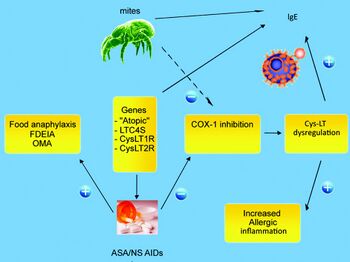Oral mite anaphylaxis
| Oral mite anaphylaxis | |
|---|---|
| Other names: Pancake syndrome | |
 | |
| Interactions between mite allergy and leukotriene-mediated inflammation | |
Oral mite anaphylaxis (OMA), also known as pancake syndrome, is a disease in which a person gets symptoms after eating food contaminated with particular mites. The disease name comes from reports of people becoming ill after eating pancakes made from contaminated wheat or corn (maize) flour.[1]
Symptoms and signs
The symptoms are allergic symptoms, especially trouble breathing, swelling of the face and throat, runny nose, cough, difficulty swallowing, and wheals.[1] Anaphylaxis can occur during exposure to NSAID drugs or exercise in people exposed to the mites.[2][3]
Cause
Dust mites are microscopic arachnids that produce very powerful allergens. If dust mites get into the food, then anyone eating the food is eating the allergens and may have an allergic reaction against them. The specific mites suspected as causing the condition are Dermatophagoides pteronyssinus, Blomia tropicalis, and Suidasia pontifica (Suidasia medanensis).[2] The latter two are the most likely to have caused the harmful effects, and they live in tropical and subtropical environments.[2]
Because the condition is triggered by eating pancakes and other cooked food, scientists expect that this means that the allergen can withstand the heat of cooking.[3]
Diagnosis
In terms of the diagnosis of Oral mite anaphylaxis we find that the following is done:[4]
- Clinical presentation
- History of rhinitis or asthma
- Positive skin test result (with the suspect flour)
Prevention
Storing flour at low temperature, such as in a freezer, could prevent contamination or kill existing mites in the flour.[3]
Treatment
The management of Oral mite anaphylaxis is done via the administration of adrenaline[5][6]
References
- ↑ 1.0 1.1 Sánchez-Borges M, Fernandez-Caldas E (August 2015). "Hidden allergens and oral mite anaphylaxis: the pancake syndrome revisited". Current Opinion in Allergy and Clinical Immunology. 15 (4): 337–343. doi:10.1097/ACI.0000000000000175. PMID 26110684. S2CID 11049409.
- ↑ 2.0 2.1 2.2 Barrera OM, Murgas IL, Bermúdez S, Miranda RJ (June 2015). "[Oral anaphylaxis by ingestion of mite contaminated food in Panama City, 2011-2014]". Revista Alergia Mexico. 62 (2): 112–117. doi:10.29262/ram.v62i2.71. PMID 25958374.
- ↑ 3.0 3.1 3.2 Sánchez-Borges M, Suárez-Chacon R, Capriles-Hulett A, Caballero-Fonseca F, Iraola V, Fernández-Caldas E (May 2009). "Pancake syndrome (oral mite anaphylaxis)". The World Allergy Organization Journal. 2 (5): 91–96. doi:10.1186/1939-4551-2-5-91. PMC 3651046. PMID 23283016.
- ↑ Mangodt, E. A.; Van Gasse, A. L.; Bridts, C. H.; Sabato, V.; Ebo, D. G. (2015). "Simultaneous oral mite anaphylaxis (pancake syndrome) in a father and daughter and a review of the literature". Journal of Investigational Allergology & Clinical Immunology. 25 (1): 75–76. ISSN 1018-9068. Archived from the original on 2021-04-19. Retrieved 2023-07-28.
- ↑ Cui, Yubao (29 August 2014). "When mites attack: domestic mites are not just allergens". Parasites & Vectors. 7 (1): 411. doi:10.1186/1756-3305-7-411. ISSN 1756-3305. Archived from the original on 2023-07-30. Retrieved 28 July 2023.
- ↑ Dodd, A; Hughes, A; Sargant, N; Whyte, AF; Soar, J; Turner, PJ (23 April 2021). "Evidence update for the treatment of anaphylaxis". Resuscitation. 163: 86–96. doi:10.1016/j.resuscitation.2021.04.010. PMID 33895231. Archived from the original on 13 June 2023. Retrieved 28 July 2023.
Further reading
- Hashizume H, Umayahara T, Kawakami Y (January 2014). "Pancake syndrome induced by ingestion of tempura". The British Journal of Dermatology. 170 (1): 213–214. doi:10.1111/bjd.12597. PMID 24032354. S2CID 38221769.
- Mangodt EA, Van Gasse AL, Bridts CH, Sabato V, Ebo DG (2015). "Simultaneous oral mite anaphylaxis (pancake syndrome) in a father and daughter and a review of the literature". Journal of Investigational Allergology & Clinical Immunology. 25 (1): 75–76. PMID 25898706.
- Sánchez-Borges M, Capriles-Hulett A, Caballero-Fonesca F (May 2006). "Oral mite anaphylaxis (pancake syndrome) also observed in children". Annals of Allergy, Asthma & Immunology. 96 (5): 755–756. doi:10.1016/s1081-1206(10)61079-4. PMID 16729794.
- Sánchez-Borges M, Capriles-Hulett A, Caballero-Fonseca F (August 2008). "Additional information on the pancake syndrome". Annals of Allergy, Asthma & Immunology. 101 (2): 221. doi:10.1016/S1081-1206(10)60215-3. PMID 18727482.